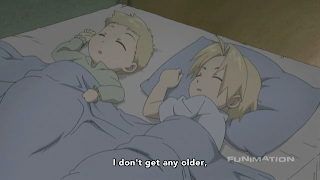Ani-Gamers staff writer Ink contributes a weekly column in which he examines the differences between the original Fullmetal Alchemist and its re-telling, Fullmetal Alchemist: Brotherhood. To read previous entries, click here.
Watch Episode 36 – Family Portrait
Personally, historically, not a single episode of FMA1 OR 2 has ever gone by this quickly! Seriously, I pressed play and then, before I knew it, the end credits were being sung over. There was no site glitch on FUNimation.com; I was just so engrossed in the story that it completely made me lose all sense of time.
We’ll start, where the episode did, with a flashback to the Elric household – mom, dad, two kids (picket fence optional). What was initially the reason behind Hohenheim’s departure in FMA1 no longer holds true. FMA2’s Hohenheim has an immortal body that is not degenerating. Also, he has told his wife about his past (or as much as to why he doesn’t age), and this inner conflict sets up a reluctant expression of love towards his sons. When alone, the episode has Hohenheim show a determination to live out his life with his family, even if it means leaving them to pursue research that might help him become mortal and the husband/father he thinks they need.
This leads to what was only a flash in FMA1 and something FMA2 has already elaborated upon: Ed and Al seeing Hohenheim leave their family house, obscured by daylight in the crack of the door. This time, however, a concentration on Hohenheim’s eyes and a well-placed cut to Ed then Al stirs up some sympathy for the emotionally burdened (and burdensome) father. This does a wonderful job of showing the reasoning behind Ed’s misconception of his father’s departure. One can also argue the different approaches of the different series though, because each is effective.
FMA1 used a degenerating body and Hohenheim’s unwillingness to sacrifice more human life to sustain his own as the impetus for abandonment, whereas FMA2 uses Hohenheim’s unwillingness to lie about his immortality to his sons and desire to age and die with them as a normal father as a connection to humanity. While FMA1’s Hohoenheim ends up sacrificing, FMA2’s is more or less working toward an eventual reunion (i.e. not sacrificing, just postponing). All in all, each fits his respective series quite well, seeing as FMA2 has yet to bring any journey to a climax, and FMA1 used Hohonheim’s ultimate sacrifice as recompense.
All this, and only 6 minutes in! Then the opening credits roll.
Kimblee meets Ed and Al for the first time in the halls of Briggs as opposed to The Devil’s nest. Though both venues are (basically) homunculus-run, the important contrast is the bluntness of FMA1 and subtlety of FMA2. As Briggs becomes of more interest to the Fuhrer and more moles infiltrate its walls, the nature of the series changes to a cat-and-mouse, secret agent style suspense drama as opposed to strict action. FMA1 had clear antagonists and protagonists that observed very distinct confrontations; the characters were more or less free to battle whenever they wanted. However, FMA2 weaves conflict into constrictive situations, giving it the edge in terms of suspense and related drama.
The only remaining direct contrast to mark is Kimblee, who continues to get the snake-of-the-year award for his distinguished accomplishments in tongue-in-cheek dialogue. Almost as evil as a homunculus, and taking pride in being so, FMA2 Kimblee trounces his FMA1 counterpart by bypassing the chain of command and receiving his orders from the Fuhrer himself, instead of the lower-ranking minions (FMA1 Greed). Is the show perhaps blurring the line between homunculus and human? If so, it’s trying to challenge FMA1’s emotional blurring of the same by turning the homunculi into humans, and doing so very competently.

